EU Discounts & Promotions | Mobio Group
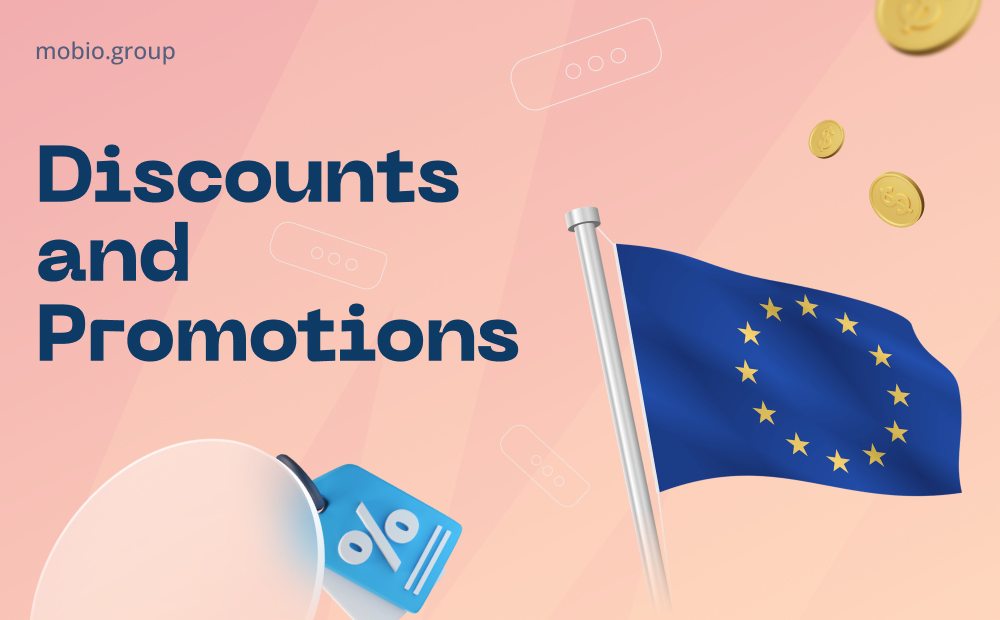
If users of your app reside within the European Union (EU) territory and your business involves online transactions with European customers, then your company must adhere to the rules and regulations governing consumer rights in the EU to protect their interests in the digital environment. Regardless of where your headquarters are located, whether it’s in USA, China, or UK, the Omnibus Directive of the EU prescribes certain rules for interacting with buyers in the European market. In this article, Mobio Group will talk about EU Discounts & Promotions. Also we’ll and explore the requirements of this directive that advertisers and business owners who offer their goods or services must fulfill.
Omnibus Directive
The Omnibus Directive combines four legislative acts applicable within the EU territory:
- Directive on Consumer Rights (2011/83/EU) — CRD
- Directive on Price Indication (98/6/EC) — PID
- Directive on Unfair Contract Terms (93/13/EEC) — UCTD
- Directive on Unfair Commercial Practices (2005/29/EC) — UCPD
The directive was scheduled to come into effect in the EU in May 2022. However, the pace of legislative work varies in different countries, and EU member states are implementing the directive gradually:
- Denmark, Norway, and major union countries — May 28, 2022,
- Sweden — September 1, 2022,
- Finland — January 1, 2023,
- Poland — January 7, 2023.
Since the changes are relatively recent and are just coming into effect, the system of enforcement supervision is not yet stringent enough. However, it is already necessary to bring your apps (or websites) and ad campaigns into compliance with European legislation.
The directive covers various aspects of the digital market. Among the changes are:
- Mandatory provision of the entrepreneur’s email address and telephone number (+ other means of contact) through which the consumer can quickly and reliably reach them
- Mandatory disclosure of information to users about paid advertisements (similar to how Google does it) and the methods of ranking goods (services) in search results on online platforms
- Strengthened protection against manipulation of user reviews
- Price transparency during promotions and discounts
Since promotions and discounts are significant tools for successful marketing campaigns and are used by almost every entrepreneur to drive business growth, let’s delve into this point in detail.
Discounts and Promotions
The new rules for conducting discount promotions aim to eliminate price manipulation by sellers. Specifically, artificially inflated prices prior to announcing a discount are now officially considered misleading and are therefore pursued at the legislative level.
According to the directive, when conducting promotions, it is advisable to:
- Clearly and unambiguously indicate in a publicly accessible place which product or service is being offered at a discounted price (push notifications or pop-ups are also appropriate if they specify the specific product or service)
- Display the price of the product or service alongside the discounted price, showing the lowest price it has been for the previous 30 days.

Discounts in Case of Price Fluctuations Withina Month
If the price of a product has increased for any reason within 30 days prior to the start of a promotion, the discount percentage and the crossed-out price should be calculated based on the regular price, not the most recent price.
For example, let’s say the current price of a product is €100. Due to increased demand before the weekend or holidays, the price rose by €20, reaching €120. Then, after the weekend, the price dropped to €70. In this case, the discount should be calculated based on the regular price of €100 (30%), not €120.
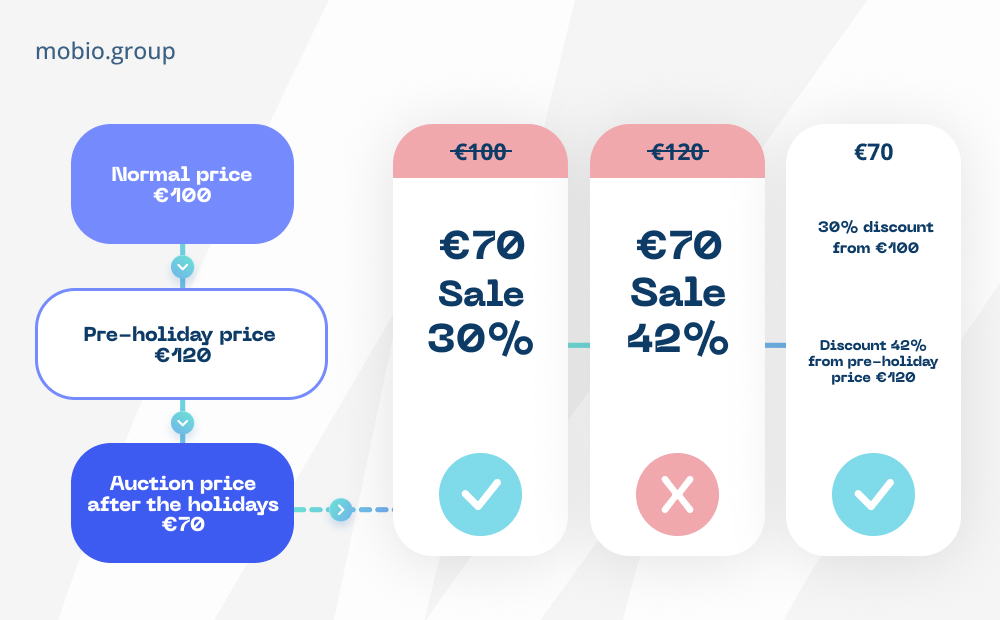
*The options for writing banners, product cards, or service pages can be varied. The main requirement of the directive is that the information must be transparent and clear to the user.
The same rule applies to prices that have been lowered multiple times within a 30-day period — the discount calculation is based on the lowest price within that month. Let’s assume you have a car rental app. The standard price is €100 for a one-day car rental. On Sundays, you lower the price (as you have fewer bookings on weekends) by 20% (which is €80). Suppose on a holiday (Christmas), due to low demand, you decide to offer the car for €50. You cannot indicate a 50% discount (€100 − 50% = €50). According to the directive, you are required to display a discount of 37.5% (€80 − 37.5% = €50) in your app since €80 is the lowest price within the past 30 days. And it must be explicitly stated.
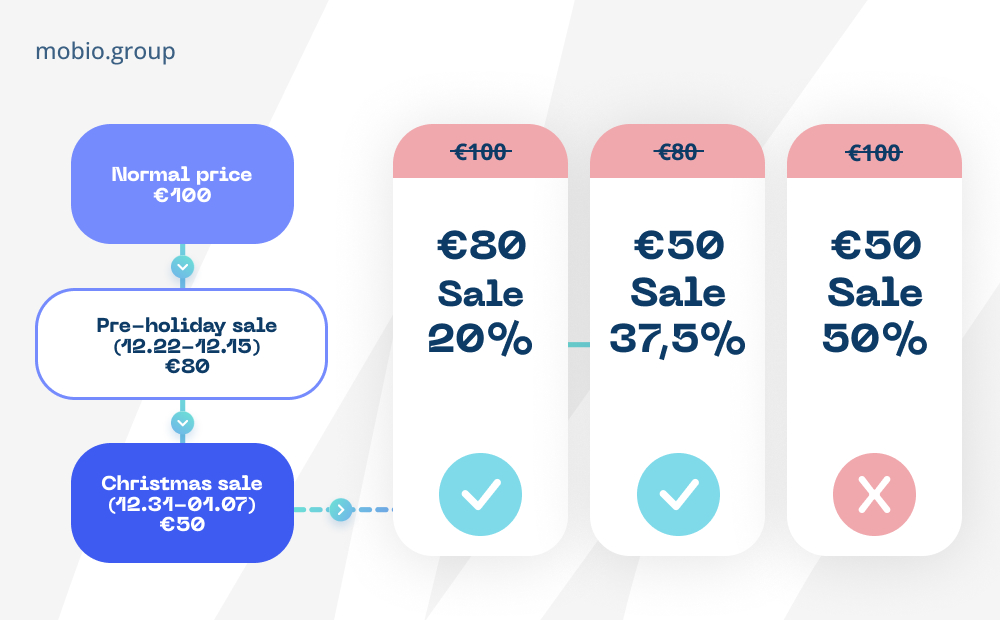
Discounts on Different Sales Channels
If a product is offered through different sales channels and a promotion is applicable across all channels, each channel must specify its own pre-promotion minimum price and corresponding discount percentage. Let’s assume you have an offline flower shop and an online app. The price of bouquets in your offline shop is cheaper since there is no delivery involved for in-store purchases. In this case, in the general advertising announcement of the discount promotion, it is required to indicate the lowest price for both the offline and online shops separately.
If the announcement (in the presence of two or more points of sale) advertises a promotion but the discount is only offered through certain sales channels (for example, only for the online app), such actions are considered unfair commercial practices and are evaluated according to the UCPD regulations.
General Discount Announcements
A seller of goods or services has the right to make general advertising announcements, such as banners or online messages, without specifying the lowest price within a month. This is applicable when the discount applies to either all products or a specific designated category. However, the obligation to inform the buyer about the minimum price within a 30-day period still remains for the seller, but this can be done directly on the product card, the interface of an online store, or the specific service page.
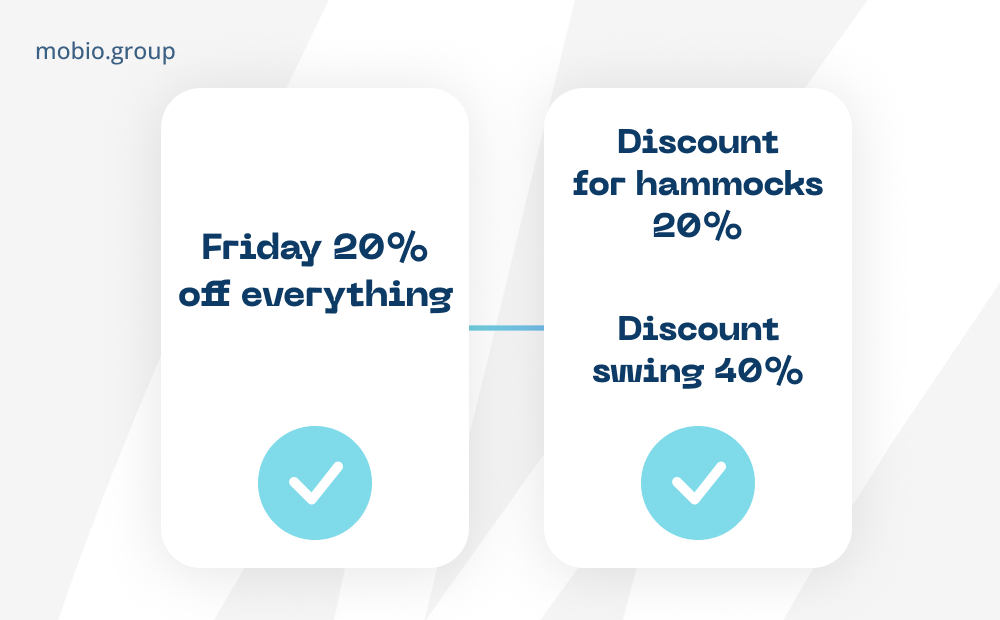
Personalized Discounts and Loyalty Programs
If a loyalty program targets a wide range of customers, even if it takes the form of personalized discounts, the app owner is obligated to comply with the directive, which means guaranteeing that the price prior to the discount is the lowest within the last 30 days. Here are some examples of advertising campaigns that can be used:
- “Only today! Show this code for a 10% discount!”
- “A 20% discount on Fridays for all loyal customers!”
The rules of the directive do not apply to:
- Personalized discounts (cumulative or related to personal dates, such as a birthday discount for the user)
- Discount card policies that have been in effect for a continuous period (6 months, a year)
- Rewarding users with discounts for specific actions:
— “Subscribe to our newsletter and get a 10% discount.”
— “Register for a loyalty card and enjoy a 10% discount every weekend.”
Gradual Price Reduction
When the price of a product or service is continuously and gradually reduced, the seller has the right to indicate the initial pre-sale price as the minimum. This is applicable if the campaign is consistent and there have been no price increases during the promotional period.
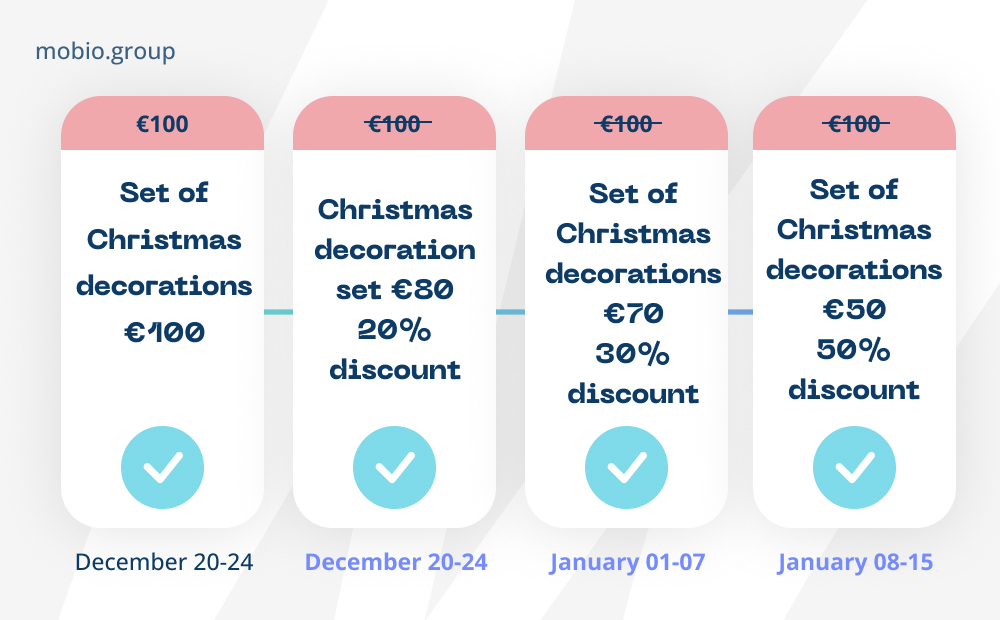
Exceptions to the Directive Rules
There are situations that fall outside the scope of the directive’s provisions. In such cases, the seller or service provider is not required to indicate the minimum price of the last 30 days or specify the corresponding discount.
These situations include:
- Price reductions that occur without announcements or visible displays
- Promotional campaigns presented as price comparisons or conditional offers, such as “Buy One, Get One Free” or “Two for the Price of One.”
- Sale of goods with a short shelf life
To illustrate the last point, let’s consider an example. Suppose you sell fresh farm strawberries through an online store, and you have a category called “Fresh Farmer’s Strawberries” (a perishable product). The regular price is €10/kg. On Friday, you offer a 20% discount (€8/kg), and on Saturday, you further reduce the price to €7/kg. After restoring the price to €10/kg on Monday, you once again lower it to €8/kg on Friday.
According to the directive’s requirements, the seller is obligated to indicate the minimum price of the previous 30 days (€7/kg in this example). However, since the product is perishable, this case falls under the exceptions, and you are allowed to indicate the pre-sale price of €10/kg and the corresponding 20% discount. With the same pricing policy but a different product (e.g., packages of ground coffee), on Friday, you would still need to indicate the price of €7 as the lowest, despite the regular price being €10.
In the constantly evolving digital landscape, it is crucial for companies to stay one step ahead and stay informed about new rules and recommendations. By doing so, you can provide your customers with first-class services and high-quality products, keeping up with changes in legislation. It’s not just about complying with the law but also earning the trust of users through transparency and clarity in your policies.
The Mobio Group team keeps track of all the current changes in the digital market, allowing us to conduct our clients’ advertising campaigns with precision and transparency. Adhering to new regulatory requirements, gaining customer trust, and preventing legal issues will undoubtedly benefit your business.


